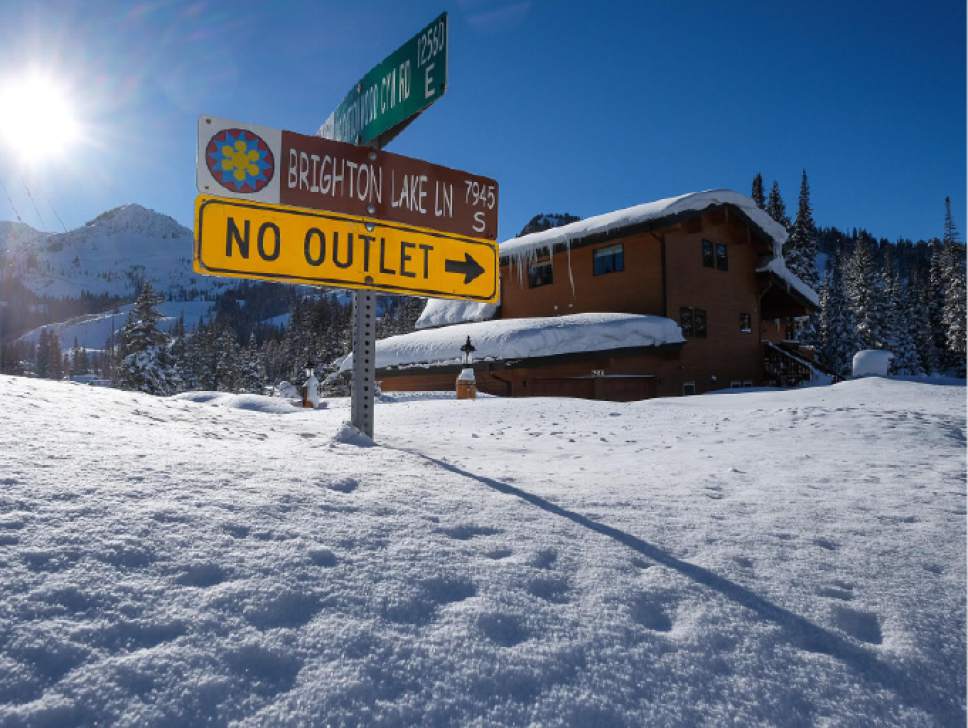This is an archived article that was published on sltrib.com in 2017, and information in the article may be outdated. It is provided only for personal research purposes and may not be reprinted.
Utah already has about half of the snow it needs to end the drought this coming spring, with three months of snow accumulation to go.
But that's the catch, said Randy Julander, Utah Snow Survey supervisor for the Natural Resources Conservation Service — with months to go before spring runoff season begins, anything can happen.
And the more immediate concern: Anticipated warmer weather this weekend could lead to flooding.
The incoming warm system is expected to produce rain, rather than snow, in the valleys, Julander said. But the past few days have been so bitterly cold that the ground likely will remain frozen — and unable to absorb rainwater.
So any unfrozen precipitation may run off and head straight toward the lowest point it can find, which, in some areas, could be the nearest basement.
Brian McInerney, a hydrologist for the National Weather Service in Salt Lake City, said this system is expected to produce an inch to an inch and a half of rain below 8,000 feet, beginning Sunday and continuing into Monday. Cache and Weber counties are likely to be the hardest hit, he said, and basement flooding is anticipated in neighborhoods that have been prone to it in the past.
Rivers in the area also are expected to rise significantly, McInerney said, so parents are advised to keep kids clear of high water.
"It's going to be kind of a soggy mess," he said, but problems should be limited to a few specific areas, and aren't likely to last long.
Snowpack above the Salt Lake City and Provo areas is currently sitting at 150 percent of normal, according to the NRCS SNOTEL network of sensors, while the rest of the state ranges from just above normal to more than 170 percent of normal.
Julander said his enthusiasm for the current situation is tempered by the realization that last year at this time, snowpack was running at about 115 percent — a high point that gave way to what ultimately became a lackluster snow season.
But Julander said he feels optimistic about a string of storms forecast for early January. If those storms pan out, he said, "that will give us a little more breathing room to keep our fingers crossed."
The National Weather Service's Climate Prediction Center anticipates above-normal precipitation totals this month, and expects that trend to continue through March, at least in northern Utah. Similarly, the U.S. Drought Monitor expects to remove its remaining drought designations in central and northern Utah in the coming month.
Despite complaints about excessive snow shoveling and slick roads, Julander said this winter does not yet qualify as exceptionally snowy.
"It certainly isn't anything outside what we would call ordinary at this point," he said. "People have forgotten what a normal winter looks like. We used to have these all the time."
In the long term, Julander said, there is still concern about reservoir storage in south-central Utah. Reservoirs across the state remain low, averaging 49 percent of capacity, according to this month's Utah Water Supply Outlook Report from the NRCS.
Reservoirs in south-central Utah are especially low — nearly empty in some cases. Even if the current trend holds, he said, these areas could struggle to come up with enough water this summer.
Gunnison reservoir, one of the worst off, "could store just about every drop of water to come down the river this year," Julander said. "But everything else is starting to look much, much better."
Twitter: @EmaPen



